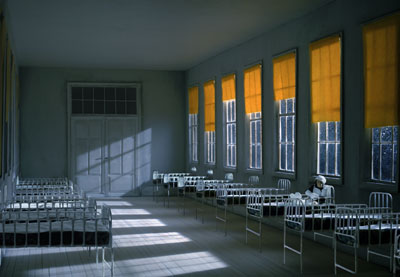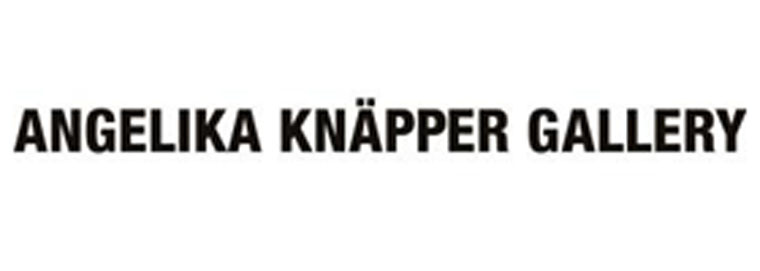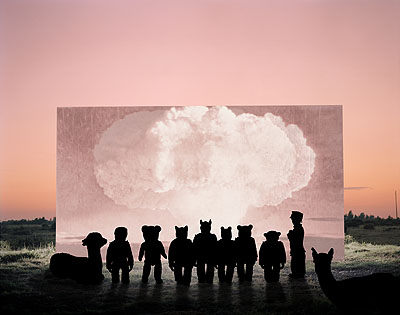
Helena Blomqvist »
The Last Golden Frog
Exhibition: 30 Aug – 28 Sep 2008

Angelika Knäpper Gallery
Tegnérgatan 4
113 58 Stockholm
+46 8-54593119
office@angelikaknappergallery.com
www.angelikaknappergallery.com
Tue-Fri 11-18 . Sat, Sun 12-16

Angelika Knäpper Gallery is pleased do announce the third solo show by Helena Blomqvist. The exhibition will be accomplished by a new catalogue. For more information please contact the gallery or visit our website. It took a while before I noticed them. The procession clothed in black progressed during silence amongst the naked trees. All wearing black, like mourners. An anonymous cortege, a black river of despondence outlining itself against the white snow. The long skirts, the capes and the big hats spoke of different and distant times. But it was first after a while I discovered that the procession did not consist of human beings but of - monkeys. Helena Blomqvist's art bares the double hallmark of philosophical reflection and a cunningly twisted sense of humor. Photography's mission is for many to describe the world, make visible what we do not notice or prefer to ignore. But Helena Blomqvist's artistic practice is not about portraying the world. Instead she builds the world, over and over again by using models and props. When she installs the camera to immortalize the scenes it is all about capturing an accomplished fact that already exists. Even though the final touches are done with digital equipment her world is already present, just as real as the everyday outside her studio. It is difficult not to be engaged by her images. Earlier she turned the gender stereotypes upside down when she portrayed women in typical macho roles such as astronauts and western heroes. She is more than familiar with the archetypes in our culture, the cornerstones that holding everything up, and to what extent they reflect the inequalities in the power balance within the society. In time her search light has come to focus on the smaller or bigger dramas taking place in her peculiar milieus. Sometimes it feels as if a course of events on the verge of apocalypse is unveiled to us: The darkness is coming, the skies are filled with armadas of bombers, the snow storm is howling, the grey houses weighs down by the load of the apocalyptic visions. Other times it is the consequence of a silent and personal resistance we witness as the old lady leaves her walking aid on the side of the lake and sets out on a skating trip on the frozen mirror of the water, the last thing she does in life. In both cases it is a world outside - or parallel - with our own which the artist involves us in for a moment. For how long time it has existed or what will happen once we have left the exhibition space will always be a mystery. Just as skillful she is in handling the cultural (not least the pop cultural) archetypes, just as sensitively she handles the photographic tradition. Classic horror movies, the photo montages from the 20'ies, surrealism, Alfred Hitchcock, David Lynch and film noir - her images incorporates basically all the important genres from the last century's photographic practices. These traditions have proven to be so strong that they more or less have come to stand for specific moods which we all can recognize. When a condition is describes as being "Hitchcok-esque" or "Lynchean", then everybody knows what is intended. The defining difference is however that Helena Blomqvist's recycling of cinematic and photographic icons does not strive for correspondence in terms of details. They are not visual rebuses or codes; it is rather a photo based stage/performing art which strives for understanding rather than recognition. In her new works she has taken this strategy yet another step. The main characters are this time played by animals - preferably monkeys - that appear to find themselves in distant times of war. The uniforms and the props have an air of early 20-th century, and when the animals temporarily are lined up in front of the sight of a mushroom cloud from an atomic bomb, it almost seems like they are incapable of making any sense of what they are witnessing. The colors are, just like in old photographs, sparsely distributed. The fields with the small red flowers, which lines out like drops of blood against the gray background, shine the strongest. It is not difficult to remind oneself of the Canadian military doctor John McCrae's poem "In Flanders Fields" from 1915, perhaps the most well known and quoted literary piece from the first world war:"In Flanders fields the poppies blow / Between the crosses, row on row, / That mark our place; and in the sky / The larks, still bravely singing, fly/ Scarce heard amid the guns below. / We are the Dead. Short days ago / We lived, felt dawn, saw sunset glow, / Loved, and were loved, and now we lie / In Flanders fields". "Poppies" were the only plants that survived in the ravaged and colorless landscape of the trench war. The blood red flowers has since then become the symbol of the nameless victims of the war, those whose illusions and lives were crushed. Just like in Helena Blomqvist's pictures we now can see the soldiers in blurry group pictures of the troop divisions that long ago have seized to exist. They belong to a world, to which the people of today have no access. In time one starts to wonder whether they have existed at all, or if they too are a product of the photo montage's vast machinery. The oblivion stands in the way of the view. But the monkeys, what are they doing there? Monkeys dressed as humans looks as if they belong to a circus. But even they have a cultural history. When the controversy about Darwin's evolutionary theory was at its worst in the 19-th century, his opponents often pointed out what they found to be absurd in his teachings by portraying him and his proselytes as monkeys wearing costumes. The fact is that the same visual argumentation is used by today's opponents to the evolutionary theory. The classic science fiction movie "The Planet of the Apes" from 1968 has another take on history, and makes the monkeys lords over the humans. At the end of the movie the main character suddenly realizes that he is not on a strange planet ruled by monkeys but in fact, its earth in a distant future. But Helena Blomqvist's monkeys are not domineering masters striving to conquer the world. They are interacting in the human tragedy, watching together with other living creatures how the sun is setting and the world getting colder. Finally all that exists is the golden frog, shuffling across the cracked and dried out ground. But perhaps there is another story to tell. In one of the pictures the little monkeys sits alone on a bed of water lilies, a thunderstorm rages in the background. The Water lily is within the eastern philosophy a symbol for both enlightenment and resurrection. There is always another angle, another possible reading. That is Helena Blomqvist's strength she trusts us to make that interpretation. Anders Olofsson
